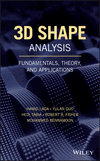Object Recognition in 3D Scenes
Summary
The task of 3D object recognition is to determine, in the presence of clutter and occlusion, the identity and pose (i.e. position and orientation) of an object of interest in a 3D scene. This chapter covers the surface registration-based 3D object recognition methods. It introduces some recent advances in machine learning-based 3D object recognition methods. Most traditional 3D object recognition methods follow a hypothesize-and-test surface registration scheme, which usually contains three modules: a feature matching module, a hypothesis generation module, and a hypothesis verification module. Several machine learning-based methods have been proposed for 3D object recognition. Examples include Hough forest-based methods and deep learning-based methods. Although deep learning has been extensively used in object recognition from 2D images, performing 3D object recognition from point clouds with deep neural networks is still an open problem. The chapter discusses few challenges for the application of deep learning to 3D data.



